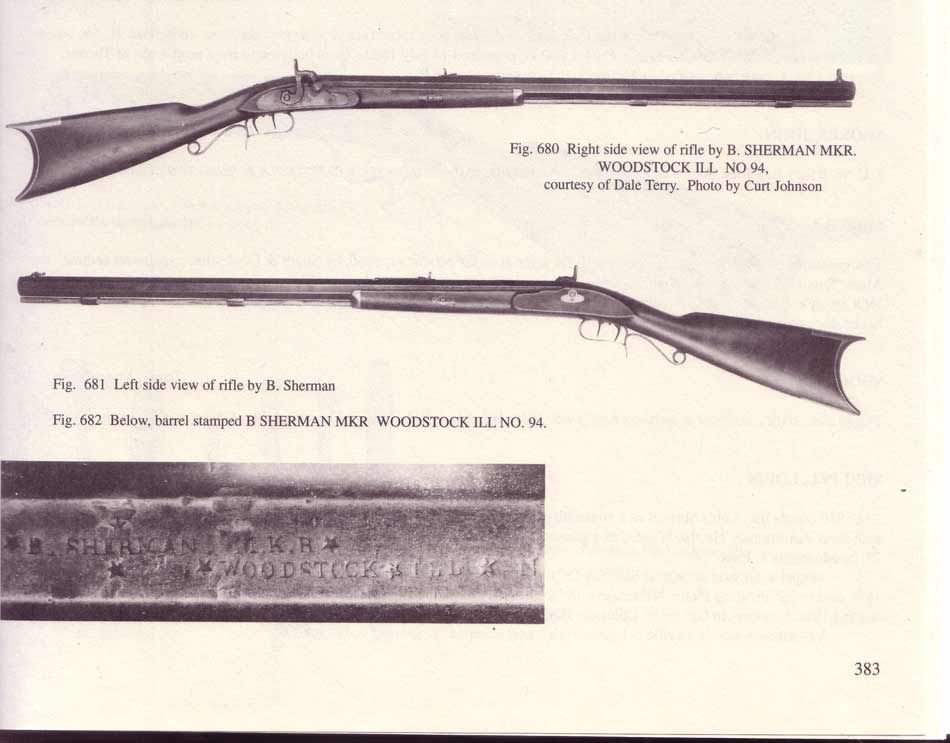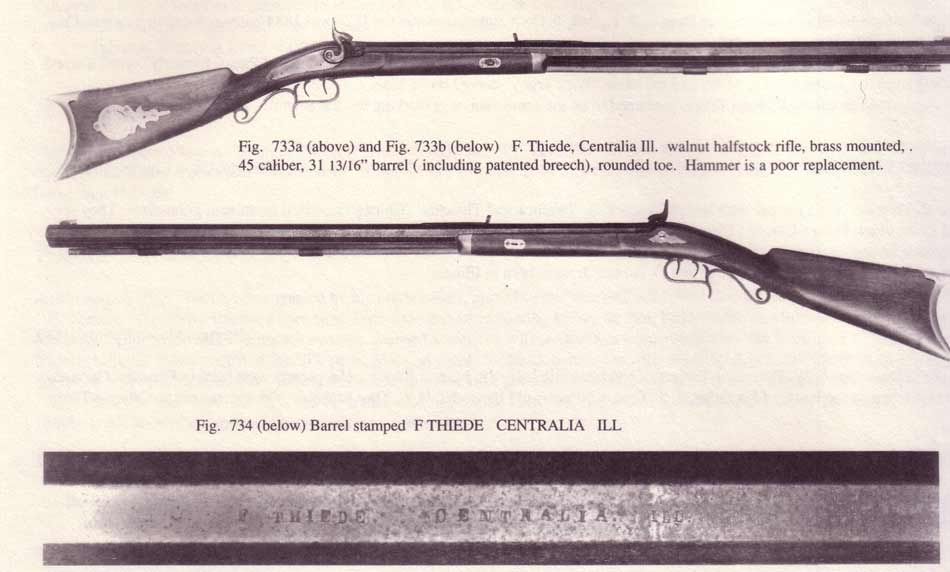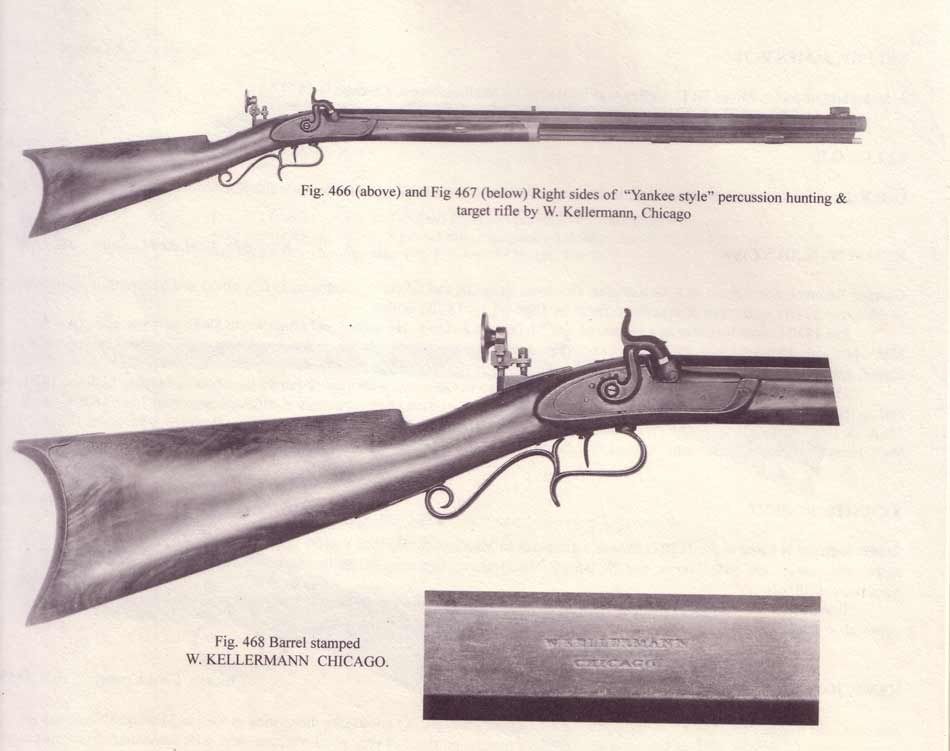It seems that every time a CVA, Traditions, Thompson Center or Lyman muzzleloader is mentioned a few folks can't hardly wait to say, "Those guns are NOT period/historically correct. Guns like those never existed." or words to that effect.
Often the short fore stock, single barrel wedge, straight octagon barrels and sights are mentioned and there is little doubt that the big boxy adjustable sights that come on many of these guns probably don't represent the sights of guns that were made in the mid to late 1800's.
The rest of the gun however does appear to be quite representative of the guns of our past.
The following photo taken from Curtis L. Johnson's "GUNMAKERS of ILLINOIS 1683-1900" George Shumway Publisher, York, Penn, 2005 has more than a few common features of the Italian and Spanish guns.

Before saying that this is just one picture of one gun I would suggest that a review of the above book be made.
Short fore arms and single barrel wedges are shown on pages 81, 91, 114, 145, 152, 193, 164, 166,175, 178, 178, 296, 271, 296, 310, 311, 312, 313,316, 319, 327, 332, 335, 336, 342, 354, 356, 365, 366, 378, 380, 382, 383, 412, 433, 439 and 469. This list excludes the obvious target guns and Schutzens shown in the books (Vol I & II) and it should be remembered, these are but a few of the guns made in Illinois not to mention the guns made in California, Ohio, Iowa, New York, and the rest of the United States.
Although guns exactly like these guns may not be Historically correct for reenacting period the Mountain Men of the 1820-1850 period there is no doubt that these guns (with minor alterations like removing the boxey adjustable rear sight) could easily be used for the time period of 1840-1870 in the more civilized areas of the Nation. They are very Traditional and they do represent an accurate recreation of the firearms made during the 1840-1870 period of our history.
That makes them both Historically and Period correct for the 1840-1870 time frame.
Before someone starts picking on the shape of the butt, I again urge them to look at the book mentioned above. There was an incredibly diverse amount of variation in stock shapes during this period.
In all fairness I will say that many of the guns shown in the photos on the pages listed above do have longer barrels than the modern reproductions but not all of them had long heavy barrels.
Often the short fore stock, single barrel wedge, straight octagon barrels and sights are mentioned and there is little doubt that the big boxy adjustable sights that come on many of these guns probably don't represent the sights of guns that were made in the mid to late 1800's.
The rest of the gun however does appear to be quite representative of the guns of our past.
The following photo taken from Curtis L. Johnson's "GUNMAKERS of ILLINOIS 1683-1900" George Shumway Publisher, York, Penn, 2005 has more than a few common features of the Italian and Spanish guns.

Before saying that this is just one picture of one gun I would suggest that a review of the above book be made.
Short fore arms and single barrel wedges are shown on pages 81, 91, 114, 145, 152, 193, 164, 166,175, 178, 178, 296, 271, 296, 310, 311, 312, 313,316, 319, 327, 332, 335, 336, 342, 354, 356, 365, 366, 378, 380, 382, 383, 412, 433, 439 and 469. This list excludes the obvious target guns and Schutzens shown in the books (Vol I & II) and it should be remembered, these are but a few of the guns made in Illinois not to mention the guns made in California, Ohio, Iowa, New York, and the rest of the United States.
Although guns exactly like these guns may not be Historically correct for reenacting period the Mountain Men of the 1820-1850 period there is no doubt that these guns (with minor alterations like removing the boxey adjustable rear sight) could easily be used for the time period of 1840-1870 in the more civilized areas of the Nation. They are very Traditional and they do represent an accurate recreation of the firearms made during the 1840-1870 period of our history.
That makes them both Historically and Period correct for the 1840-1870 time frame.
Before someone starts picking on the shape of the butt, I again urge them to look at the book mentioned above. There was an incredibly diverse amount of variation in stock shapes during this period.
In all fairness I will say that many of the guns shown in the photos on the pages listed above do have longer barrels than the modern reproductions but not all of them had long heavy barrels.






